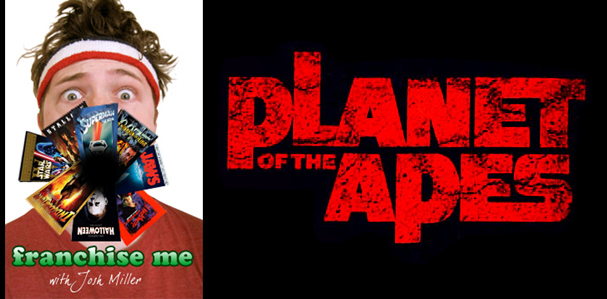
Hollywood loves a good franchise. The movie-going public does too. Horror, action, comedy, sci-fi, western, no genre is safe. And any film, no matter how seemingly stand-alone, conclusive, or inappropriate to sequel, could generate an expansive franchise. They are legion. We are surrounded. But a champion has risen from the rabble to defend us. Me. I have donned my sweats and taken up cinema’s gauntlet. Don’t try this at home. I am a professional.
Let’s be buddies on the Facebookz!
The Franchise: Planet of the Apes — chronicling the epic and turbulent history of a civilization of evolutionary advanced apes – particularly the bloodline of two chimps, Zira and Cornelius – and their relationships with humankind. The franchise spawned from Pierre Boulle’s 1963 novel La Planète des singes, and spans five original-series films, a theatrical remake, two television series, and a new prequel-re-boot hitting theaters August 5.
The Installment: Planet of the Apes (1968)
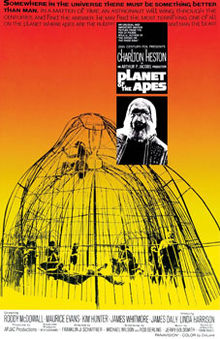
The Story: A crew of four astronauts, led by the cynical and misanthropic Colonel Taylor (Charlton Heston), are accidentally sent off course while in hyper-sleep, and crash land on an alien world where apes rule and humans are little more than wild animals; mute and unintelligent. Taylor suffers a neck injury while being captured by the apes and is left unable to speak, and thus unable to fully demonstrate his awesome mental prowess. But an “animal” psychologist, Zira (Kim Hunter), senses something different about Taylor and takes special interest in him, naming him “Bright Eyes” and giving him a female to bang, Nova (Linda Harrison). When Taylor finally regains his voice the ape world is thrown into a fervor, and Taylor, Zira, her archeologist boyfriend Cornelius (Roddy McDowall) all come into the cross-hairs of a powerful government orangutan named Dr. Zaius (Maurice Evans). As the ruling apes’ fear of Taylor continues to grow, a conspiracy and long buried secret begins to emerge.
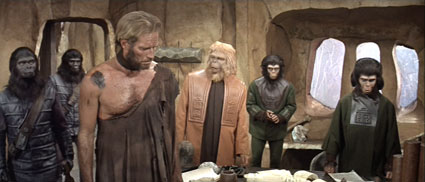
What Works: Planet of the Apes is a landmark genre film for good reason. It’s pretty effing great.
First and foremost there is John Chambers’ Academy Award-winning make-up FX. Chambers’s career with make-up began while crafting prostheses for wounded and deformed soldiers at a United States Department of Veterans Affairs hospital. He also created Spock’s pointy ears, and partook in one of the zaniest strange-but-true CIA missions ever (according to IMDb, John Goodman shall be playing him in the forthcoming movie retelling of said zany mission). But his lasting achievement will always be Planet of the Apes. What was so astonishing about Chamber’s designs and prosthetics in 1968 wasn’t how amazing it all looked. Audiences had seen amazing make-up before — Jack Pierce had already shown audiences what was possibly back in the 1930’s with the Universal monsters, after all. What was so mind-blowing about Apes was just how much make-up we’re seeing. This isn’t just The Wolf Man or Frankenstein’s Monster. We’ve got an entire civilization of apes. Gorillas. Orangs. Chimps. Males. Females. Children. Teenagers. Adults. Elderly. The genius of Chamber’s design is how simple yet effective it is — easily replicated over many actors. Background apes were of course just actors wearing one-piece Halloween masks, but the difference in quality was negligible. And while the facial mobility (or lack there of) of the make-up now seems a bit quaint, it is still remarkably effective for the most part…
…especially with the right actors. A Streetcar Named Desire‘s Kim Hunter is particularly successful at registering emotion through all the bullshit on her face. Her eyes are so vibrant you completely forget that when she speaks her mouth woodenly claps open and shut like a ventriloquist dummy. Roddy McDowall utilizes a bit of acting trickery, giving himself little ticks and such that add implied animation to his face. Of our three lead apes, Maurice Evans is most prone to what I’d call “dead puppet-face,” but the man does wonders with his bearing and that fucking amazing voice of his. Enough cannot be said about Dr. Zaius. He is an extremely captivating villain, both in what Evans adds to the character with his surly ‘tude, and what was written. Which brings me to the film’s second biggest success: the script.
Adapted by Rod Serling, then re-written by Michael Wilson, Apes‘ script is a bit of a surprise. You don’t expect a movie like this to be so smart (at least I certainly didn’t when I first saw it many moons ago). There is a lot of allegory and subtext to the film, some blatant, some slier, and very little of it is played as comical satire. The film’s late-60’s peacenik posturing is a bit dated, but its attitudes on religion and illiberal politics are timeless and quite complex for a movie about talking apes. There are themes of animal rights and classicism throughout, but at its core the movie is a rather damning critique on the combination of church and state and more specifically on the narrow-mindedness of conservatism, as it relates to scientific/academic progression. What’s ultimately so interesting about this, though, is Serling’s signature Twilight Zone-esque twist ending, that retroactively makes Dr. Zaius seem like significantly less of a villain when the motivation behind all his secret keeping is suddenly revealed to Taylor and us. “Don’t look for it, Taylor. You may not like what you find.”
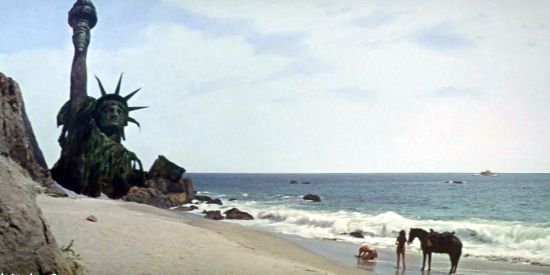
Pierre Boulle apparently was not a fan of Serling’s ending, but he was wrong (the ending to his novel is actually pretty stupid; look it up). If anything, the ending is what makes the movie. Taylor’s discovery that he’s in fact been on Earth the entire film remains one of cinema’s greatest twist endings, and certainly contains one of the medium’s most iconic single images (the one above). It is a testament to the quality of Apes that already knowing the twist going into the film does nothing to diminish the moment’s impact. Frankly, Apes really telegraphs the twist with all the talk of space-time time dilation at the top of the film. Even back in 1968 I have to imagine a sharp viewer might have gotten suspicious thinking, “Why bother with all this talk if this is a movie about astronauts simply crashing on an alien world?” Especially when combined with the Earthlings’ discovery of the planet’s primitive humans. “They look more or less human,” our heroes say. More or less? Um, you mean completely human? I think the natural response to this discovery would be, “Holy shit! Humans! Are we on Earth thousands of years in the future?!” But again, the ending is amazing and features some face-melting signature Heston “acting.”
Charlton Heston, like John Wayne or even Arnold Schwarzenegger, is an acquired taste. I can fully appreciate why some people find his performances laughable or even terrible. I can see it. But I can also see the awesomeness. Heston is a master ham, in the best ways, and Apes finds him in top form. I’m surprised Heston didn’t get diabetes from all the scenery chewing he does here — the man is ravenous. From his overly earnest opening monologue in which he leaves a message for Earth asking, “Does man, that marvel of the universe, that glorious paradox who sent me to the stars, still make war against his brother? Keep his neighbor’s children starving?” To his great exclamation, “It’s a madhouse!” To his teeth-grittingly delivered classic line, “Take your stinking paws off me, you damned dirty ape!” To his fist-pounding-into-the-sand final lines, “You maniacs! You blew it up! Ah, damn you! God damn you all to hell!” Heston’s masterful cheese aside, what I love about Taylor is what a fucking prick he is. He has to be one of the most intriguingly unlikable protagonists ever to grace a major mainstream motion picture. He’s smug, misanthropic, and mean-spirited. After that smug manly-hippie opening monologue, and after surviving the crash, the first real character interaction we’re given with Taylor is his bullying of his flightmate Landon (Robert Gunner), in which he’s basically trying to break Landon’s spirits – repeatedly pointing out that everyone Landon ever knew and loved is dead – for no other reason than to sadistically amuse himself. Taylor thinks humanity sucks. He volunteered for the space mission to get away from people. The Serlingian irony of course being that he gets his wish and doesn’t like it.
Franklin J. Schaffner’s presentation is tonally perfect. Dead serious, but with just enough lightness that it never feels like the movie is taking itself too seriously. The introduction of the apes is kickass — with the Earthlings’ first encounter with the mute humans suddenly being interrupted by the sound of hunting horns. The mutes run into a field of tall grass, and the apes are first only seen by the sticks they’re beating the grass with to drive the humans into nets, before Taylor finally catches a glimpse of a fury bastard on horseback. You already know the apes are coming, and you already know what they look like, but you can still feel Taylor’s “What the fuck?!” It’s an exciting chase sequence that then ends in a bit of dark comedy when we see several gorillas happily posing for a picture over a pile of dead humans as though they were big game safari trophies. I also really liked the moment, right after the ship has crashed, when Taylor finds Stewart, the female member of the crew, dead in her hyper-sleep bunk. The close-up of her shriveled remains is met with a sharp squealing noise that at first seems like soundtrack emphasis but turns out to be the hull cracking open, with water promptly exploding into the ship. That’s some quality sound editing right there.
And enough cannot be said about Jerry Goldsmith’s ground breaking avant-garde score. Half the film’s emotional impact comes from Goldsmith’s moody, percussion-heavy music. The Oscar that year when to John Barry for The Lion in Winter, which is a good score, but Goldsmith’s proved far more iconic and influential.
Also, the set design. The novel was set in an ape civilization that mirrored the technological and architectural advances of modern Earth. Too expensive to realize that vision, the ape world was scaled back to a more primitive and feasible level of civilization. This naturally altered the basic concept of the film too, all for the better. And the film’s strangely shaped stone structures and sets add another layer of eery surreality to the already surreal concept.
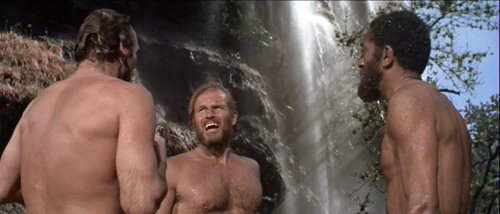
“We’re the only humans on this planet.”
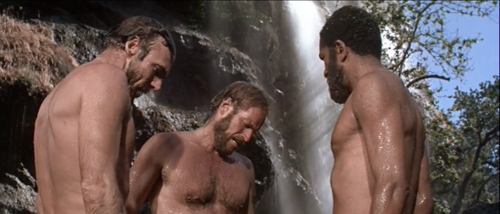
“I can work with that.”
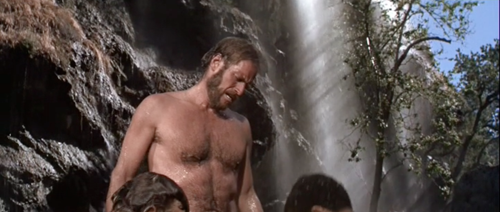
“Chalk up another victory to the human spirit.”
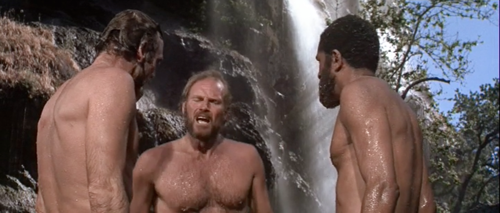
“What happens on the Planet of the Apes, stays on the Planet of the Apes.”
What Doesn’t Work:
Nova. Yes, I know Linda Harrison is extremely attractive. I have eyeballs. But her performance is terrible, which is a pretty goddamn impressive feat considering she has a grand total of zero lines of dialogue. Nova was an iffy character to begin with, but Harrison’s performance pushes it across the line. There is the basic implication that Taylor is boning Nova or at least plans to (why else take her with him at the end?). In real life I’d do the same. She’s hot, and there aren’t exactly a lot of options on the planet of the apes. But this is a movie, and in movie terms there is something a little creepy about her presence as Taylor’s “love” interest. She’s always making confused sad puppy eyes, and at no point in the film does she move beyond this. She seems retarded. Though obviously the humans reproduce, she seems completely non-sexual, childlike. I can’t help but imagine that a Taylor/Nova sex scene would be similar to the retard-rape scene from Death Wish 2. The knowledge that Harrison was only in the movie because she was getting jamboned by 20th-Century Fox president Richard D. Zanuck makes her presence make a lot more sense contextually, but certainly doesn’t improve the character itself. Eye-candy aside (and she’s undeniably great eye-candy), Nova represents a missed opportunity for drama. I think it makes Taylor a bit less interesting that he’s so cool with having a completely silent and unintelligent girlfriend. “You know, back on Earth, I used to wish that my golden retriever looked like a Playboy Playmate, so I could fuck it.” His only frustration with Nova comes in a scene where he’s written something in the sand for Zira to see and Nova erases it, but it isn’t a moment of interpersonal frustration. Apes took the other aspects of its high-concept seriously, but Nova was a b-movie tack-on to get some pretty eyes/tits in the mix.
There are also a few areas in which we can see where Apes was forced to pull its punches that should have been cleaned up a bit. Realistically (and conceptually) the humans would all be naked — we’re the chimps in this world. This wasn’t ever going to happen, not in an expensive mainstream movie. That’s fine. Humans wear tattered rags. We accept it. But then Zira marvels at the fact that Taylor has turned an old blanket into clothes. This is supposed to be a sign of his unusual intelligence. But all humans wear clothes. This is a very minor gripe, but one that could very easily have been snipped from the script. Just ignore the subject. Taylor is clearly different from the rest of the humans anyway.
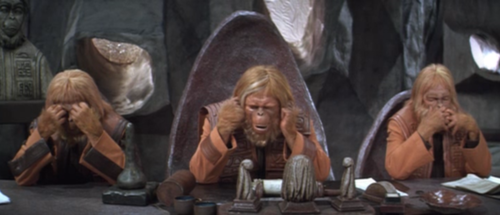
Silliest Primate Gag: When the trio of orangutans overseeing Taylor’s trial fall into the classic See No Evil, Hear No Evil, Speak No Evil pose.
Best Jackass Heston Line: “Imagine me needing someone. Back on Earth I never did. Oh, there were women. Lots of women.”
Best Inverted Reality Line: Julius dismissing Taylor’s pre-speaking intelligence. “You know the saying, “Human see, human do.””
Awkward Inter-Species Moment: Taylor wanting to kiss Zira at the end of the film.
Fucked Up Ending: After being set free by Dr. Zaius, Taylor and Nova ride off into the forbidden zone where they discover the destroyed remnants of the Statue of Liberty. Then Taylor starts singing, “Oh my god, I was wrong. It was Earth all along. Well, you’ve finally made a monkey, yes you’ve finally made a monkey out of me.” Or something like that.
Should There Have Been a Sequel: You are kind of left wondering what Taylor does once he stops punching the sand and swearing. So yeah, sure.

Up Next: Beneath the Planet of the Apes
previous franchises battled
Leprechaun
Tremors
Critters
Death Wish
Police Academy
Phantasm